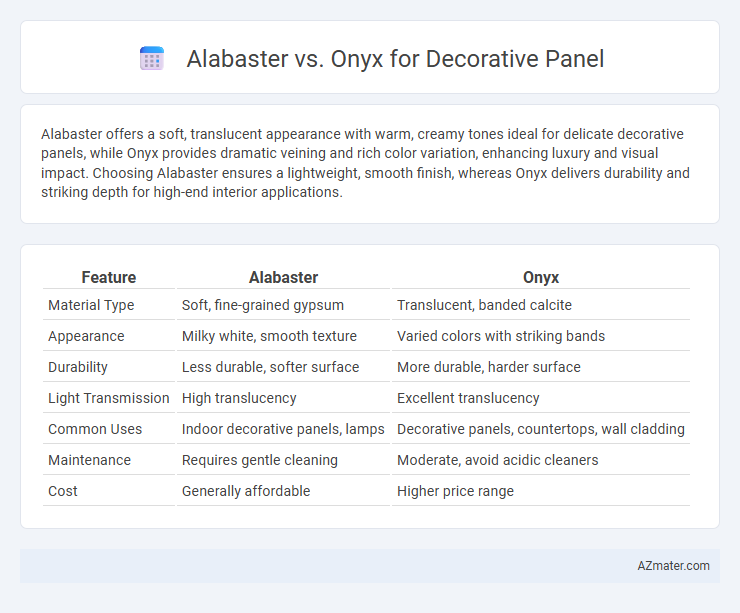Alabaster offers a soft, translucent appearance with warm, creamy tones ideal for delicate decorative panels, while Onyx provides dramatic veining and rich color variation, enhancing luxury and visual impact. Choosing Alabaster ensures a lightweight, smooth finish, whereas Onyx delivers durability and striking depth for high-end interior applications.
Table of Comparison
| Feature | Alabaster | Onyx |
|---|---|---|
| Material Type | Soft, fine-grained gypsum | Translucent, banded calcite |
| Appearance | Milky white, smooth texture | Varied colors with striking bands |
| Durability | Less durable, softer surface | More durable, harder surface |
| Light Transmission | High translucency | Excellent translucency |
| Common Uses | Indoor decorative panels, lamps | Decorative panels, countertops, wall cladding |
| Maintenance | Requires gentle cleaning | Moderate, avoid acidic cleaners |
| Cost | Generally affordable | Higher price range |
Introduction to Alabaster and Onyx Decorative Panels
Alabaster decorative panels are prized for their translucent, milky white appearance and soft, smooth texture, making them ideal for creating elegant, light-diffusing surfaces in interior design. Onyx panels stand out with their rich, vibrant banding and natural translucency, offering a luxurious and dramatic aesthetic suited for backlit feature walls and high-end applications. Both materials are valued for their unique visual properties and durability, enhancing decorative panels with a blend of natural beauty and functional elegance.
Unique Properties of Alabaster: Beauty and Versatility
Alabaster stands out in decorative panels for its translucent quality, allowing soft, ambient light to pass through, creating a warm and inviting atmosphere. Its fine-grained texture and natural veining offer exceptional beauty and a smooth finish, enhancing the elegance of interior spaces. The material's versatility enables it to be carved into intricate designs or used as large, seamless panels, making it ideal for both traditional and contemporary decorative applications.
Distinctive Features of Onyx for Interior Design
Onyx is renowned for its translucent quality and rich, vibrant color patterns, making it a standout choice for decorative panels in interior design. Its ability to be backlit enhances architectural elements by creating luminous effects that add depth and sophistication to spaces. Unlike alabaster, onyx offers greater durability and a wider palette of shades, from milky whites to deep ambers and greens, allowing for versatile aesthetic applications.
Visual Appeal: Comparing Alabaster and Onyx Aesthetics
Alabaster offers a soft, translucent glow with creamy white or pale hues, creating an elegant and subtle ambiance for decorative panels. Onyx features vibrant colors and pronounced veining that produce a bold, dramatic visual impact, ideal for statement pieces. Both materials provide distinct aesthetic qualities; Alabaster excels in diffused light effects, while Onyx captivates with its intense contrast and rich patterns.
Durability and Maintenance: Alabaster vs Onyx Panels
Alabaster panels offer moderate durability but are more prone to scratching and etching due to their softness compared to onyx panels, which are harder and more resistant to wear. Maintenance for alabaster requires gentle cleaning with non-acidic, pH-neutral solutions to prevent surface damage, while onyx panels can tolerate a wider range of cleaning products but still need sealing to protect against stains and moisture. Onyx generally provides better long-term resilience for decorative panels in high-traffic or humid environments, making it a preferred choice for durability and easier upkeep.
Light Transmission and Backlighting Effects
Alabaster exhibits a soft, diffused light transmission ideal for creating warm, ambient backlighting effects, while onyx offers higher translucency with striking natural veining that enhances dramatic illumination. The uniform texture of alabaster ensures an even glow, making it suitable for subtle decorative panels, whereas onyx's complex patterns create dynamic light interplay, often used to achieve bold visual statements. Both materials excel in light-enhancing applications, with alabaster favored for gentle, consistent backlighting and onyx preferred for intense, texture-rich lighting designs.
Installation Considerations for Alabaster and Onyx
Alabaster, being softer and more porous than onyx, requires careful handling and sealing during installation to prevent damage and staining. Onyx panels, known for their hardness and translucency, demand precise cutting and professional adhesive selection to maintain structural integrity and aesthetic appeal. Both materials necessitate professional expertise for installation to ensure longevity and prevent cracking or discoloration under varying environmental conditions.
Cost Comparison: Budgeting for Decorative Panels
Alabaster decorative panels typically range from $50 to $120 per square foot, offering a more affordable option compared to onyx panels, which can cost between $100 and $250 per square foot due to onyx's rarity and translucency. Installation costs for onyx are generally higher because of its fragility and the precision required, impacting overall budgeting. When planning for decorative panels, factoring in both material and labor expenses is crucial to align with project budgets while maintaining desired aesthetics.
Best Applications: Where to Use Alabaster or Onyx Panels
Alabaster panels excel in diffusing light, making them ideal for backlit wall features, countertops, and decorative ceiling panels in luxurious interiors. Onyx panels, prized for their rich veining and translucency, are perfect for statement pieces such as fireplace surrounds, bar fronts, and accent walls where dramatic visual impact is desired. Both materials suit upscale residential and commercial spaces, with alabaster favored for softer, ambient lighting effects and onyx chosen for bold, vibrant aesthetics.
Choosing the Right Material: Alabaster vs Onyx for Your Project
Alabaster offers a soft, translucent quality ideal for warm, diffused lighting in decorative panels, making it perfect for creating a cozy ambiance. Onyx boasts a bold, striking appearance with natural veins and higher durability, suited for dramatic accent walls and areas demanding visual impact. Select Alabaster for subtle elegance and gentle light diffusion, or choose Onyx to achieve vibrant color contrasts and robustness in high-traffic spaces.

Infographic: Alabaster vs Onyx for Decorative Panel
 azmater.com
azmater.com